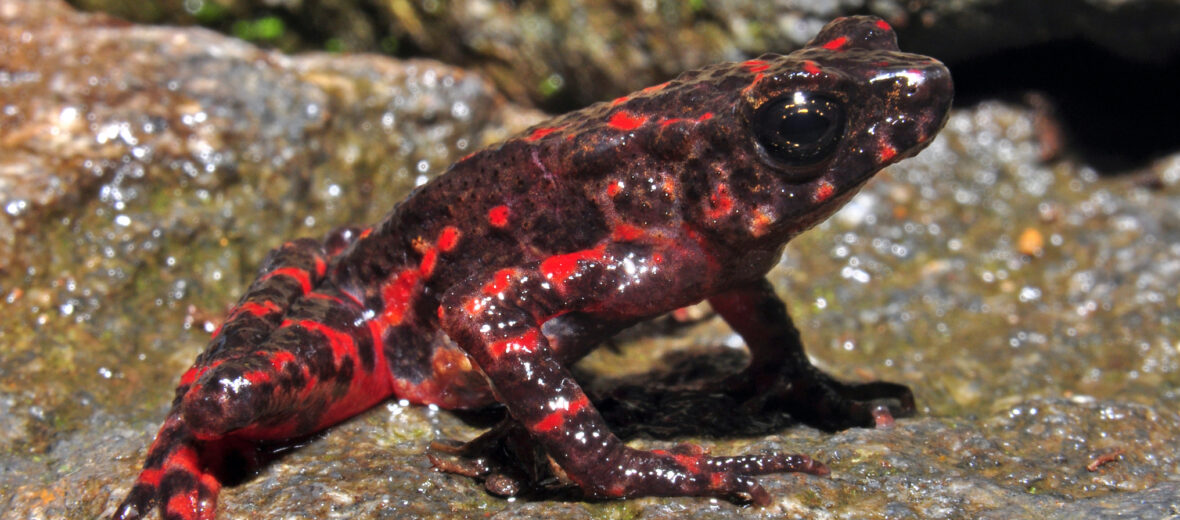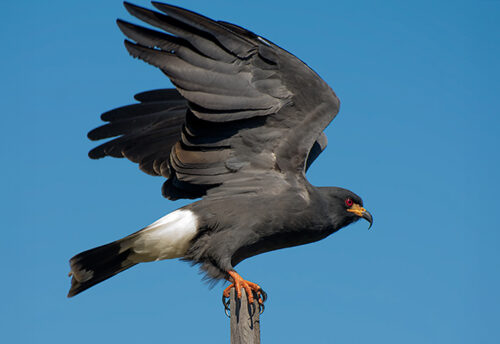
The bleeding toad, aka fire toad or Indonesian tree toad, hails only from western Java, the Mount Gede Pangrango National Park area, and from Mount Halimun Salak National Park. They prefer boundary zones between the moist lowland regions and mountainous forests. Sadly, these toads face the threats of habitat loss and destruction at the hands of mining; recreational activities that interrupt their breeding grounds; hunting; trapping; volcanic activity; and they are also being wiped out due to chytridiomycosis (Batrachochytrium dendrobatidis and Batrachochytrium salamandrivorans). Chytrid has decimated amphibian populations the world over, causing up to 90 known extinctions.
First the Stats…
Scientific name: Leptophryne cruentata
Weight: Up to .13 ounce
Length: Up to 1.57 inches
Lifespan: Up to 10+ years
Now on to the Facts!
1.) The IUCN lists these toads as Critically Endangered.
2.) These toads dwell at altitudes of up to 3,900 – 6,600 feet above sea level.
3.) They get their namesake due to the red markings on their back and the skin secretions that occur when they’re threatened.
4.) Crickets, locusts, caterpillars, and earthworms are all on the menu.
5.) As climate change and global warming causes a rise in temperatures, the toads are driven to higher and higher elevations that might not be suitable for breeding.
But wait, there’s more on the bleeding toad!
6.) The eruption of Mount Galungung also poses a constant threat to these amphibians.
7.) These toads reproduce in slower moving vernal streams.
Did you know…?
It is estimated that there are fewer than 250 wild specimens remaining.
8.) Like all toads, the females are larger than the males. This is so that the female can support the weight of the male grasping onto her back (amplexus) while mating.
9.) Females only lay up to 27 eggs each breeding season. With this low of a number, it causes an issue with their being able to bounce back from potential extinction.
10.) If threatened, they, like other toads, can produce a poisonous substance called bufotoxin from their parotid glands, which is typically a white, fatty, sticky substance. These toads aren’t known for being extremely toxic though.
But wait, there’s still more on the bleeding toad!
11.) Dragonfly larvae and some birds prey on these toads.
12.) As of June 2022, Bogor Agricultural University and the Chester Zoo have been developing an ex situ (off site) breeding program for bleeding toads. Let’s hope these programs can successfully breed and reintroduce the toads to their natural habitat before it’s too late.
Now a Short Bleeding Toad Video!
This video talks about toads in general.
Be sure to share & comment below! Also, check out the Critter Science YouTube channel. Videos added regularly!
Want to suggest a critter for me to write about? Let me know here.
Some source material acquired from: Wikipedia & IUCN
Photo credit: iNaturalist Canada



